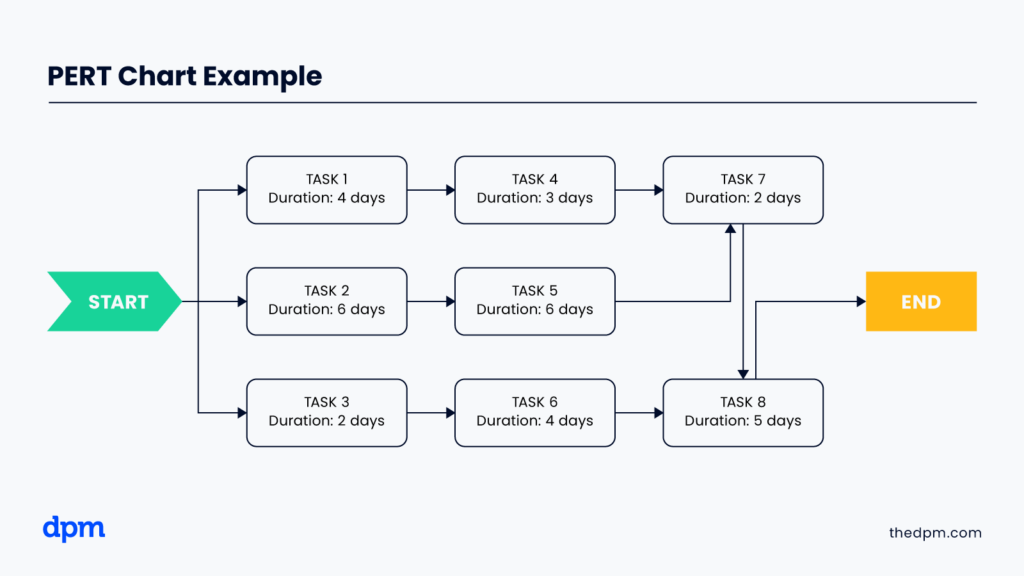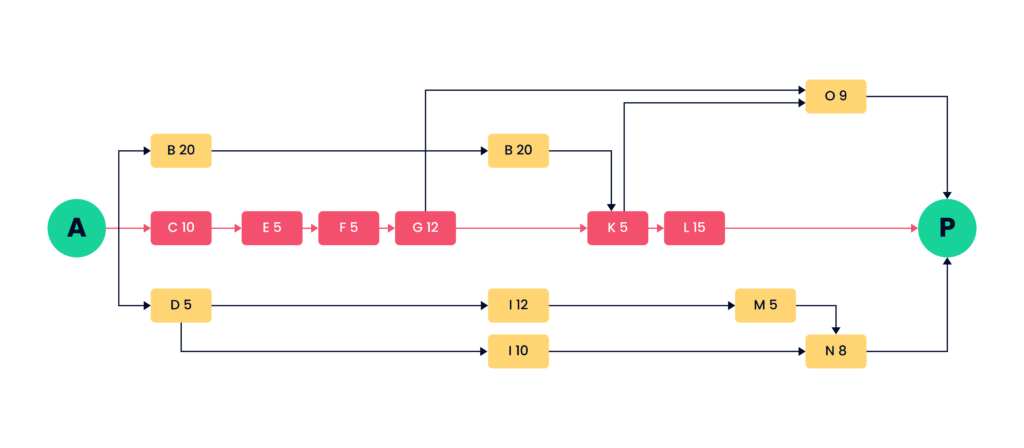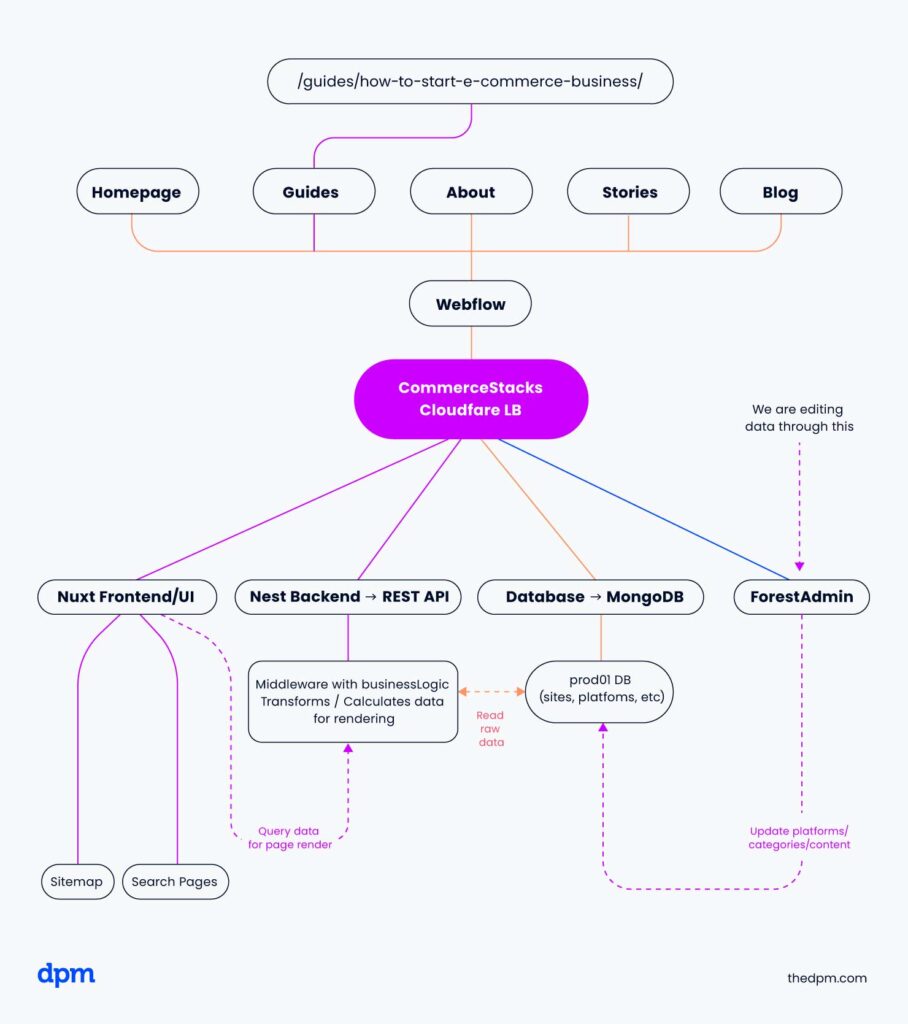The difference between PERT (Program Evaluation and Review Technique) and CPM (Critical Path Method) is that PERT is used when projects have more flexible timelines or more uncertainty, and CPM is used when there is a fixed timeline and you have exact details about each task that needs to be completed.
Both are supported by most common project management software that you'll encounter.
What Is PERT?
PERT (program evaluation and review technique, or sometimes project evaluation and review technique) is a technique for calculating the timeline of a project. PERT charts, which represent the timeline as nodes and lines between the nodes, offer a holistic view of the project by:
- Breaking down the project into specific milestones, represented as the nodes
- Analyzing the time needed for each task, which are represented by the lines
- Understanding the interdependencies between them
Using your PERT chart, you can calculate three estimates for how long the project will take.
- An optimistic estimate, i.e. the fastest possible timeline
- A pessimistic estimate, i.e. the longest possible timeline
- The most likely estimate, i.e. the most reasonable estimate

Pros of PERT
- Flexibility is key: Unlike some rigid methods, PERT is adaptable. You can adjust timelines as you gain better insights or face unexpected hiccups.
- Risk awareness: By evaluating multiple timelines (an optimistic time, a pessimistic time, and the most likely time), PERT prepares you for the best and worst scenarios. It's the ideal method when navigating uncharted territories or if uncertainty is high.
- Clearer project visualization: With its unique network diagram, PERT lays out all tasks and their inter-relationships in a clear visual format. Perfect for those moments when you must explain the intricacies to stakeholders or team members.
- Focus on key tasks: PERT ensures you prioritize the tasks that matter the most. It's like having a spotlight on the show-stoppers, so you never miss a beat. Non-critical activities are ranked with lower priority but are still completed based on their importance.
Cons of PERT
- Time-intensive: Crafting a PERT diagram can sometimes feel like assembling a jigsaw puzzle. It's detailed and requires substantial time investment, especially for complex projects.
- Based on estimates: Remember the multiple timelines we mentioned? While they offer a range of possibilities, they're still based on estimates. This can occasionally lead to inaccuracies in the projected timeline of the project duration.
- Complexity can be overwhelming: PERT might be overkill for smaller projects or those with a clear path.
- Frequent re-evaluations needed: The dynamic nature of PERT means that as project conditions change, you'll often need to revisit and adjust your charts. It demands vigilance and continuous attention.
What Is CPM?
CPM, or critical path method, is the sequence of tasks determining how fast you can reach the project's completion time. This is the longest path through a project—any delay in these tasks and your project end date gets pushed.
Both critical and non-critical tasks are assigned a fixed start, end, and amount of time. It's about understanding the domino effect: if one task in the critical path gets delayed, what's the ripple effect on the subsequent ones?
But CPM is about more than just identifying this all-important path. It's about optimizing it. By constantly evaluating the progress and adjusting the flow of project activities, CPM ensures that the project stays on track, even if unforeseen challenges pop up.
So, when you're armed with CPM, you're not just moving from point A to B. You're doing it with a well-thought-out plan, ensuring each step propels you toward the end goal in the quickest, most efficient manner possible.

You might also consider using the critical chain method as an alternative.
Pros of CPM
- Precision matters: CPM gives you a precise timeline. There's clarity in what needs to be done and when. It's your project's metronome, keeping everything in rhythm and pace, from the minimum time and activity duration to the sequence of activities and overall project schedule.
- Resource optimization: By laying out a clear path, CPM allows managers to allocate resources where they're most needed. No more overstretching or understaffing—every resource is just right.
- Cost-effective: Time is money, as they say. By optimizing task sequences, CPM can help reduce overhead and keep projects within budget.
Cons of CPM
- Less flexibility: While PERT adapts on the go, CPM is more rigid. This means sudden changes can be trickier to manage.
- Not ideal for uncertain projects: For projects where task durations are uncertain or if there's a lot of unpredictability, CPM may not be the best fit.
- Demands detailed data: The precision of CPM comes at a cost. It requires exhaustive, detailed data about each task.
- Regular monitoring needed: While this is true for most methods, CPM's emphasis on the critical path means any slip-up can affect the entire project timeline. Hence, meticulous monitoring becomes essential.
8 Key Differences Between PERT Vs CPM
While these project management techniques may seem similar at first glance, PERT and CPM have distinct characteristics. Let's break down these differences, so you can confidently choose the right approach for your project.
- Event Oriented vs Activity Oriented
- Unpredictable Activities vs Predictable Activities
- Controlling Time vs Time-Cost Trade-Off
- One-Off Projects vs Repetitive Projects
- Probability Model vs Deterministic Model
- Milestones as Chart Nodes vs Tasks as Chart Nodes
- No Distinction For Critical Activities vs Distinguishing Critical Activities
- No Resource Crashing vs Resource Crashing
1. Event Oriented vs Activity Oriented
At the heart of PERT is the concept of events. Think of these events as checkpoints in a marathon—significant points where you assess your progress. It's about reaching these checkpoints and ensuring everything's on track. Events in PERT don't consume time or resources—they merely mark a point of achievement.
CPM is all about the journey between these checkpoints. The activities, or tasks, are the main focus. These are the tangible steps that consume time and resources. In CPM, these activities and their durations get mapped out, helping project managers understand the project flow.
2. Unpredictable Activities vs Predictable Activities
PERT's design caters to the unknown. When working on groundbreaking projects without precedent, estimations are naturally filled with uncertainty. PERT accepts this unpredictability, offering multiple time scenarios (optimistic, most likely, and pessimistic) for each activity to help managers prepare for various outcomes.
CPM, meanwhile, requires a level of predictability. It demands accurate data about each activity's duration. Activities have a fixed start and end time, giving managers a clear view of when each task should begin and conclude, making it easier to monitor and control all activities of the project. This statistical technique helps to gauge high precision time estimations and where dependencies can alter the algorithm for this method.
3. Controlling Time vs Time-Cost Trade-Off
PERT is all about optimizing time. Given the inherent uncertainties in task durations, managers using PERT are often trying to ensure that projects complete within a reasonable time estimate, even if the exact duration is fluid.
CPM introduces another layer: cost. With its precise nature, CPM lets managers play with the trade-off between time and cost of the project. For example, can you afford to extend a deadline if it means reduced costs? Or would you rather speed things up, even if it means a budget increase? CPM lays this out clearly.
4. One-Off Projects vs Repetitive Projects
The PERT technique shines when every project is a new frontier. Tasks and their sequences might not have a past reference, making every move feel pioneering. It's perfect for unique projects that might not be repeated in the future.
CPM, however, is ideal for repetitive projects where tasks and their sequences are well-known and can be predicted based on past experience. With CPM, managers can refine and perfect their approach with every iteration.
5. Probability Model vs Deterministic Model
PERT acknowledges uncertainty and operates in a probabilistic realm. It doesn't claim to predict the future but offers a range of possibilities to equip managers for a range of outcomes across all activities of a project.
CPM doesn't like leaving things to chance. It's deterministic, thriving on solid data. Each task's duration is set in stone, offering a clear path the project should ideally follow without room for deviation.
6. Milestones as Chart Nodes vs Tasks as Chart Nodes
In PERT diagrams, each node represents a milestone or event. They offer a snapshot of the project's progress. Imagine charting out the first draft of a software design, then the prototype, followed by the first testing phase.

CPM's diagrams, in contrast, focus on tasks. Each node signifies a tangible step. For example, if you're developing a new app, one node might represent the UI design, another the backend development, and so on. This gives a clear picture of the tasks that lead to the project's end goal.

7. No Distinction For Critical Activities vs Distinguishing Critical Activities
In PERT, every event is vital, but there needs to be a distinct emphasis on which activities leading up to these events are more crucial than others. It's more about ensuring each milestone is achieved within the expected time frame.
CPM brings the spotlight to critical activities. Identifying the critical path distinctly marks those tasks that are pivotal for the project. Delay in these tasks? Your whole project gets delayed. It's about knowing and focusing on the backbone of your project.
8. No Resource Crashing vs Resource Crashing
Resource crashing might sound dramatic, but in CPM, it's about fast-tracking tasks by adding more resources. Think about those times when, facing a tight deadline, you pull in extra hands to get things done faster. That's resource crashing.
PERT? Not so much. While PERT is agile and adaptive in managing time, it doesn't often manipulate resources to adjust timelines. Its primary focus is on re-evaluating and adjusting time frames based on the evolving nature of the project.
When To Use PERT vs CPM
Use PERTs charts when you have more flexibility when it comes to the project timeline, or when you don’t have all the details about each task or activity. Use CPM when your timeline is more rigid and you have enough information to make accurate estimates about the time each task or activity will take.
PERT charts are also typically used for more complex and large-scale projects, such as construction or engineering, especially if there are no external constraints on the deadline. CPM works better for smaller projects with tight timelines—the longer a project goes on, the more uncertainty there is about future tasks and activities, and the higher the chance of changes that will throw off your critical path.
What's Next?
Want to learn more about the right project management tools and project methodologies that can make the difference on your project? Become a DPM member and join the conversation in Slack with 1000+ other digital project managers!


